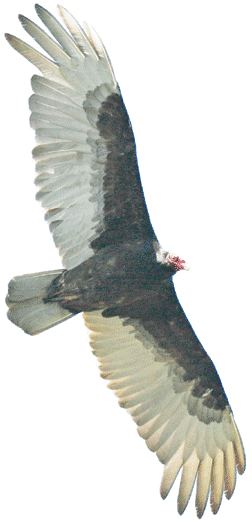Trick and Treat
Vultures look and act ghoulish, but they provide more than a good fright
by Maureen Miller
“What’s black and red, sends shivers down your spine, is called a kettle in the air and a venue on the roof?” asked my friend as we walked the village streets to the dock.
Before I could guess, he answered: turkey vultures. There they were, quietly sitting on dock, trash can and dumpster, sending shivers down my spine. It’s with pure envy, however, that I watch these black-bodied, red-headed birds soar and glide on high.
My bird-watching friend taught me to identify the creatures when I first moved to Bay Country. As we searched for bald eagles, I spied a lone bird drifting lazily above. I pointed, held my breath and waited for confirmation.
“No,” was the reply. “That’s a turkey vulture, an ugly carrion eater. You can tell by the V-shaped wings.”
Mom always said not to judge a book by its cover. If there was ever a being that shouldn’t be quickly judged, it’s the American turkey vulture.
Unlike lily-white gulls, turkey vultures share. Faced with a meal too large for one, the finder will return to the roost to extend a gracious dining invitation. Fastidious and picky eaters, these scavengers are known to turn up their noses at rotten meat, preferring fresh road kill and plenty of vegetation. Afterwards, they’ll carefully preen or take a bath, then stand spread-winged, called a horaltic pose, to dry their wings, warm their body and bake off bacteria.
While turkey vultures are basically gentle and non-aggressive creatures, they don’t stand by idly when threatened. Instead they have a disgusting way of warding off predators: They vomit. By coughing up lumps of stinky, semi-digested meat, they are able to deter creatures trying to raid their nests. A vulture needing to flee in the middle of a meal will regurgitate any un-digested material, lightening its load as well as leaving behind a free, already-been-chewed distraction.
With a small, bald, red head designed for digging deep into carcasses, turkey vultures easily shake and flick off drying bits. Their stomachs digest even poisoned or bacterial-filled carrion, yet their droppings are completely germ free — a matter scientists study with fascination.
Turkey vultures are assiduous about ridding their bodies of bacteria acquired while dining. In addition to bathing and baking, they urinate on their legs. Because their urine contains strong acids from their digestive system, it kills any bacteria accumulated while stepping in and on a meal. As a side benefit, the evaporating urine acts as air-conditioning in the summer.
These intelligent birds possess far keener senses of smell and eyesight than do their cousins, the endangered California condor. Whether searching for food or merely playing with the thermal wind currents, vultures are unbeatable for beauty, precision and stamina in flight. Rising to amazing heights, gliding and soaring for up to six hours without flapping a wing, or diving at speeds up to 60 miles per hour, vultures are wondrous fliers.
Distant cousins of the Africa griffon vulture, which can swallow bones as well as meat, they are related only in name (and bald head) to our Thanksgiving centerpiece. Our New World vultures flourish from southern Canada to the southern tip of the North American continent. Long ignored by our park services, rehabilitation societies and others who looked to the classier birds like hawks, eagles and falcons to draw attention and money, the American turkey vulture resolutely fulfills its dual job description as nature’s garbage collector and sanitizer.
The Turkey Vulture Society, founded in 1994, celebrates this amazing creature. If people only knew more about them, says Richard Dilks, founder of the annual springtime East Coast Vulture Festival in Wenonah, New Jersey, we might even grow to love them. At least appreciate them.
I’ll try to remember all this the next time I see a venue perched on my roof.
Read on at http://vulturesociety.homestead.com/index.html.
Maureen Miller, formerly of Galesville, continues to contribute to Bay Weekly from St. Marys, Georgia. Her last story was The Schooner Mystic (Vol. xv, No. 41: Oct. 11).
